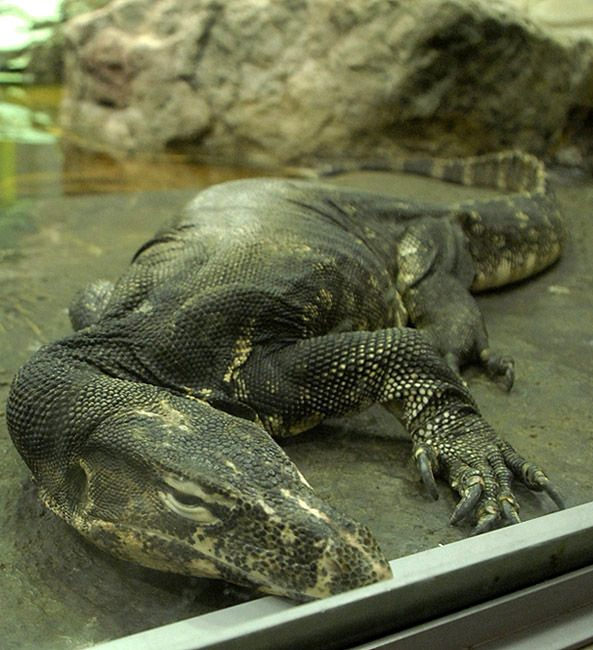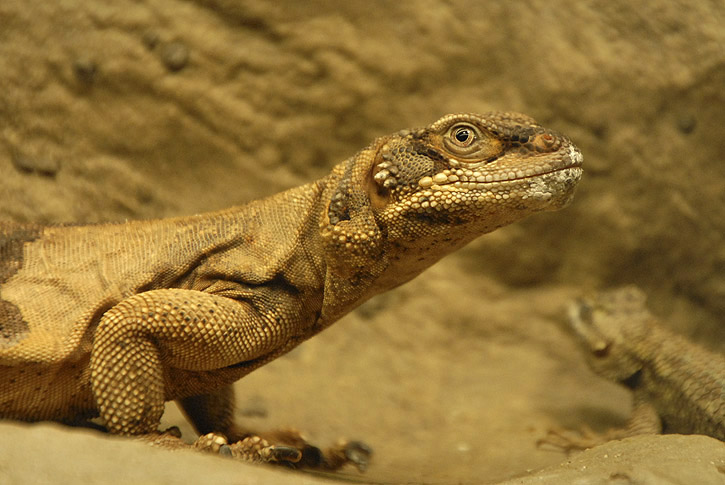California Academy of Sciences: Snakes and Lizards
California Academy of Sciences: Snakes and Lizards
For D.'s recent birthday we spent a special day in San Francisco at the California Academy of Sciences in Golden Gate Park, noted for its recent make-over, including their special summer exhibit Snakes and Lizards (or as I liked to call it, Lakes and Snizzards). Here are some of the pics I took.
The rhinoceros iguana (Cyclura cornuta) eats leaves, flowers, berries, and fruits.

Gila monsters are the only venomous lizard in the U.S. Their species status is threatened due to habitat loss.

The water monitor (Varanus salvator) is native to southern Asia and likes to hang out on river banks and in swamps. A powerful hunter, it will eat any animal it feels like going after (including unearthing human corpses).

Amazonian tree boa, a beautiful snake.

The Gabon viper's camouflage coloration helps it blend in perfectly with the fallen leaves and bark of the forest floor.

Eastern green mambas are very good tree climbers. They eat birds, rodents, frogs and lizards. They are highly venomous, but less aggressive than black mambas.

The beautiful scales of the red spitting cobra (Naja pallida).

The Burmese python folds up compactly for easy storage.

The giant day gecko shows us its magic super-grip hands.


I like them French fried potaters. Mmm.

When the frilled lizard is feeling threatened, it gapes its mouth open and unfurls its neck frills, appearing huge and scaring away the predator (theoretically).

Eastern water dragon (Physignathus sp.) is the largest dragon lizard in Australia, growing to over a yard in length from snout to tail. It eats a variety of insects and aquatic organisms, including frogs, as well as fruits.

This chuckwalla has a fierce expression. Are they sure it isn't a chucknorris?

Chuckwallas are found in arid regions of the southwestern United States and northern Mexico.
Whee, piggy-back ride!

It is strange to see such a commonplace creature as the Western fence lizard in a museum exhibit, because we see them all the time in the hills, and even in town in the more arid places.

Collared lizards (Crotaphytus collaris) can run along on their hind legs, resembling little dinosaurs. They are native to North America.


More pics:
Rainforests here.
Coral Reef here.
African Hall here.
California Coast here.
Miscellaneous here.
.
For D.'s recent birthday we spent a special day in San Francisco at the California Academy of Sciences in Golden Gate Park, noted for its recent make-over, including their special summer exhibit Snakes and Lizards (or as I liked to call it, Lakes and Snizzards). Here are some of the pics I took.
The rhinoceros iguana (Cyclura cornuta) eats leaves, flowers, berries, and fruits.

Gila monsters are the only venomous lizard in the U.S. Their species status is threatened due to habitat loss.

The water monitor (Varanus salvator) is native to southern Asia and likes to hang out on river banks and in swamps. A powerful hunter, it will eat any animal it feels like going after (including unearthing human corpses).

Amazonian tree boa, a beautiful snake.

The Gabon viper's camouflage coloration helps it blend in perfectly with the fallen leaves and bark of the forest floor.

Eastern green mambas are very good tree climbers. They eat birds, rodents, frogs and lizards. They are highly venomous, but less aggressive than black mambas.

The beautiful scales of the red spitting cobra (Naja pallida).

The Burmese python folds up compactly for easy storage.

The giant day gecko shows us its magic super-grip hands.


I like them French fried potaters. Mmm.

When the frilled lizard is feeling threatened, it gapes its mouth open and unfurls its neck frills, appearing huge and scaring away the predator (theoretically).

Eastern water dragon (Physignathus sp.) is the largest dragon lizard in Australia, growing to over a yard in length from snout to tail. It eats a variety of insects and aquatic organisms, including frogs, as well as fruits.

This chuckwalla has a fierce expression. Are they sure it isn't a chucknorris?


Chuckwallas are found in arid regions of the southwestern United States and northern Mexico.
Whee, piggy-back ride!


It is strange to see such a commonplace creature as the Western fence lizard in a museum exhibit, because we see them all the time in the hills, and even in town in the more arid places.

Collared lizards (Crotaphytus collaris) can run along on their hind legs, resembling little dinosaurs. They are native to North America.


More pics:
Rainforests here.
Coral Reef here.
African Hall here.
California Coast here.
Miscellaneous here.
.